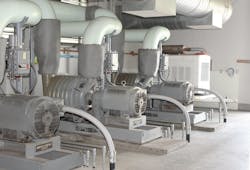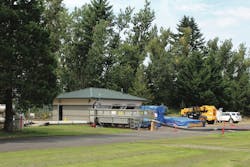About the author:
Sara Myers is former associate editor for WWD. For more information, email [email protected].
A 20-year old wastewater treatment plant turned to an energy savings solution to face aging equipment issues.
The city of Troutdale, Ore., recently partnered with Ameresco to utilize an Energy Savings Performance Contract (ESPC) model. Troutdale Public Works Director Fred Ostler heard about the project through his predecessor who “did all the leg work” and was responsible for establishing the contract with Ameresco.
“The city does not have an elaborate water system. It is just groundwater wells,” Ostler said. “They only have five of those. It was not a lot to be gained there.”
The plant was around 20 years old, and Ostler said most plants between 15 and 20 years old are due for an upgrade because the lifecycle of most components are coming to an end. Also, it creates an opportunity to adopt new technologies to make the facility more efficient.
In its search, the city found Ameresco, which put together a program based on energy savings. Consultants prequalify through the company’s main office, and end users or municipalities can choose from the list of those prequalified to contract,
Ostler said.
“We are very interested in the wastewater treatment plant market in general. A lot of these plants are 20, 30 or 40 years old and in many cases they were over-designed and that was the case,” said Lou Maltezos, executive vice president of Ameresco. “Troutdale anticipates a certain rate of population growth, and if that does not get achieved over the decades, they are left with more plants than they need. When the equipment starts to get old, if they go with a normal replacement, they are basically spending more money than they have to because rather than focusing on the life cycle costs based on the current size and needs of the plant, they are sort of refurbishing the existing equipment.”
Right-Sizing
The class 4 plant produces 3 million gal per day on what used to be a Superfund site, which Ostler said was among the first Superfund sites in the U.S.
A large aluminum plant on the land closed in the 1970s when the water plant moved onto the property. The parcel, Ostler said, is oversized, and the city has only used half of its capabilities in the last 20 years. Because the space was available on purchase, the city used the opportunity to size the infrastructure to the capacity of the plant’s predicted usage. The population growth expectation, however, did not occur, leaving assets at the plant unused.
“One half of its aeration basins have never been used,” Ostler said. “If you can imagine that there is these two aeration basins side by side. One has been used for 20 years, and the other side has been dormant, and we are waiting for those customers to come along.”
Ameresco replaced one of the blowers instead of three with an efficient new blower that can be modulated such that it can handle 80% of the whole need for the plant while using a lot less energy. This results in significant energy savings.
“I think we estimated a 40% reduction in the energy used for the aeration process just by replacing the one boiler,” Maltezos said. “That was a nice approach that we could bring because we work in partnership with the plant operators to look at the lifecycle clock as opposed to what is the lowest upfront cost to replace the blowers.”
The city of Troutdale now anticipates to gain a lot of efficiency, especially in energy use by properly sizing the blowers, pumps and motors. Through the use of variable frequency drives, and more efficient ultraviolet disinfection, the city anticipates additional savings as well.
“I just think that this is a different sort of challenge. Often times you are working with plants that are at capacity, but uniquely this plant was not at capacity. And that was wherein lies the problem,” said Leila Dillon, vice president of marketing and communications at Ameresco.
“A lot of the efficiencies that they could have been getting, they were not getting because of the way it was originally developed. So, I think one of the unique things about this project is how do you take such a massive amount of infrastructure and understand the usage that it needs today while planning for the future and make it as absolutely efficient as possible.”


